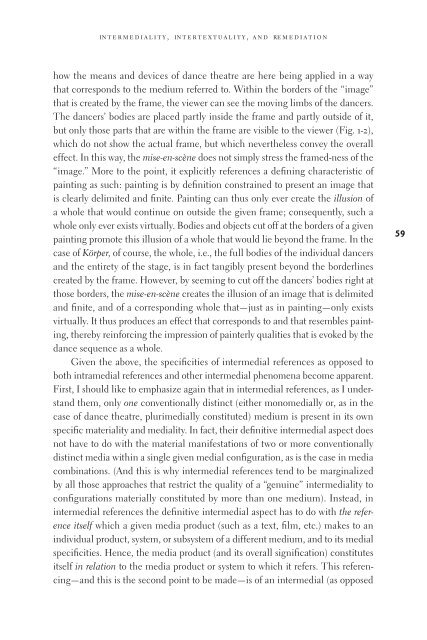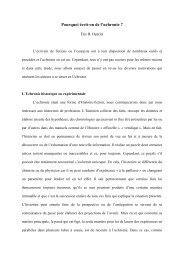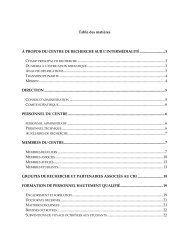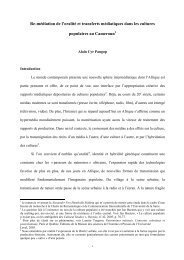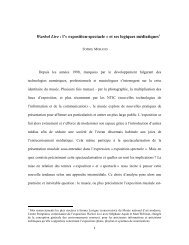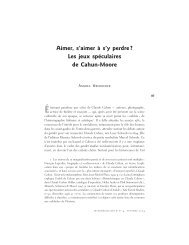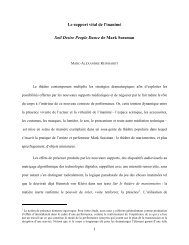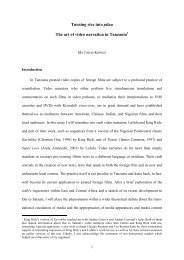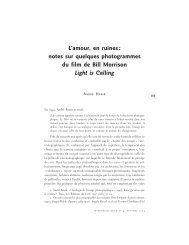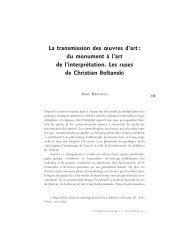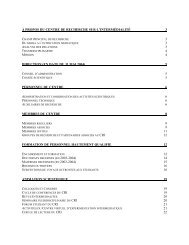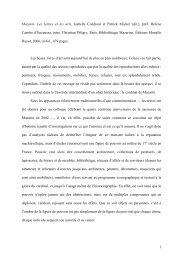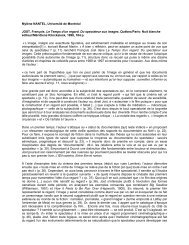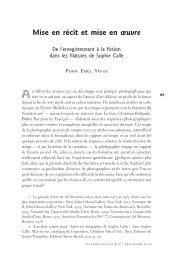Intermediality - Centre de recherche sur l'intermédialité (CRI ...
Intermediality - Centre de recherche sur l'intermédialité (CRI ...
Intermediality - Centre de recherche sur l'intermédialité (CRI ...
You also want an ePaper? Increase the reach of your titles
YUMPU automatically turns print PDFs into web optimized ePapers that Google loves.
intermediality, intertextuality, and remediation<br />
how the means and <strong>de</strong>vices of dance theatre are here being applied in a way<br />
that corresponds to the medium referred to. Within the bor<strong>de</strong>rs of the “image”<br />
that is created by the frame, the viewer can see the moving limbs of the dancers.<br />
The dancers’ bodies are placed partly insi<strong>de</strong> the frame and partly outsi<strong>de</strong> of it,<br />
but only those parts that are within the frame are visible to the viewer (Fig. 1-2),<br />
which do not show the actual frame, but which nevertheless convey the overall<br />
effect. In this way, the mise-en-scène does not simply stress the framed-ness of the<br />
“image.” More to the point, it explicitly references a <strong>de</strong>fi ning characteristic of<br />
painting as such: painting is by <strong>de</strong>fi nition constrained to present an image that<br />
is clearly <strong>de</strong>limited and fi nite. Painting can thus only ever create the illusion of<br />
a whole that would continue on outsi<strong>de</strong> the given frame; consequently, such a<br />
whole only ever exists virtually. Bodies and objects cut off at the bor<strong>de</strong>rs of a given<br />
painting promote this illusion of a whole that would lie beyond the frame. In the<br />
case of Körper, of course, the whole, i.e., the full bodies of the individual dancers<br />
and the entirety of the stage, is in fact tangibly present beyond the bor<strong>de</strong>rlines<br />
created by the frame. However, by seeming to cut off the dancers’ bodies right at<br />
those bor<strong>de</strong>rs, the mise-en-scène creates the illusion of an image that is <strong>de</strong>limited<br />
and fi nite, and of a corresponding whole that—just as in painting—only exists<br />
virtually. It thus produces an effect that corresponds to and that resembles painting,<br />
thereby reinforcing the impression of painterly qualities that is evoked by the<br />
dance sequence as a whole.<br />
Given the above, the specifi cities of intermedial references as opposed to<br />
both intramedial references and other intermedial phenomena become apparent.<br />
First, I should like to emphasize again that in intermedial references, as I un<strong>de</strong>rstand<br />
them, only one conventionally distinct (either monomedially or, as in the<br />
case of dance theatre, plurimedially constituted) medium is present in its own<br />
specifi c materiality and mediality. In fact, their <strong>de</strong>fi nitive intermedial aspect does<br />
not have to do with the material manifestations of two or more conventionally<br />
distinct media within a single given medial confi guration, as is the case in media<br />
combinations. (And this is why intermedial references tend to be marginalized<br />
by all those approaches that restrict the quality of a “genuine” intermediality to<br />
confi gurations materially constituted by more than one medium). Instead, in<br />
intermedial references the <strong>de</strong>fi nitive intermedial aspect has to do with the reference<br />
itself which a given media product (such as a text, fi lm, etc.) makes to an<br />
individual product, system, or subsystem of a different medium, and to its medial<br />
specifi cities. Hence, the media product (and its overall signifi cation) constitutes<br />
itself in relation to the media product or system to which it refers. This referencing—and<br />
this is the second point to be ma<strong>de</strong>—is of an intermedial (as opposed<br />
59


